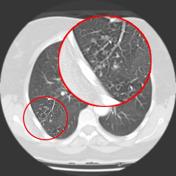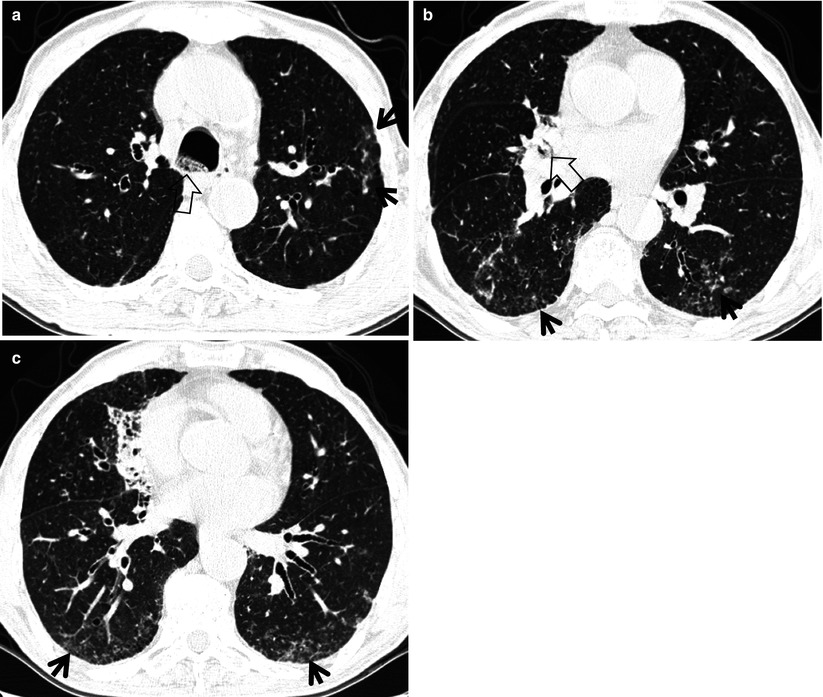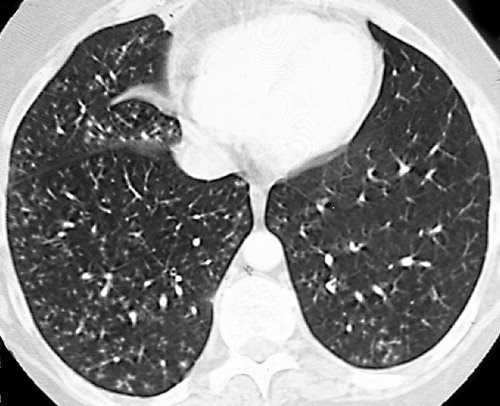tree in bud opacities pneumonia
Chest radiography had demonstrated signs of bronchiectasis and several scattered nodules Figure 2. When abnormal imaging will most often appear as a bronchiolitis tree-in-bud opacities on CT or subtle perivascular interstitial opacities on chest radiographs a bronchopneumonia tree-in-bud opacities and patchy regions of consolidation on CT or multifocal areas of consolidation on chest radiographs or as multifocal pneumonia multifocal areas of consolidation on CT and chest.

Hrct Scan Of The Chest Showing Diffuse Micronodules And Tree In Bud Download Scientific Diagram
HR-CT patterns seen in OP are.

. Here Patel and colleagues showed an association between the presence of the vascular tree-in-bud pattern yes vs. There is no associated bronchiectasis bronchial wall thickening consolidation cavitation or lymphadenopathy. Multiple causes for tree-in-bud TIB opacities have been reported.
Pneumonia due to respiratory syncytial virus in a 23-year-old man with leukemia. And tree-in-bud branching opacities detected throughout both lung fields after aspiration. Radiology scientific expert review panel.
No and duration of ventilation and hospitalization at the time of CT imaging with a majority of patients who demonstrated vascular tree-in-bud on CT imaging experiencing 10 or more days of ventilation and hospitalization both P 001. A Thin-section CT scan of the right lung shows centrilobular ground-glass opacities in addition to nodules and tree-in-bud opacities arrow. Tree-in-bud TIB appearance in computed tomography CT chest is most commonly a manifestation of infection.
The tree-in-bud pattern can be an early sign of disease Fig 10 15. Malignancy can be associated with the tree-in-bud sign. The differential for this finding includes malignant and inflammatory etiologies either infectious or sterile.
Tree-in-bud refers to a pattern seen on thin-section chest CT in which centrilobular bronchial dilatation and filling by mucus pus or fluid resembles a budding tree. There is no lower lobe predominance as the distribution is quite diffuse. However to our knowledge the relative frequencies of the causes have not been evaluated.
In radiology the tree-in-bud sign is a finding on a CT scan that indicates some degree of airway obstruction. The purpose of this study was to determine the relative frequency of causes of TIB opacities and identify patterns of disease associated with TIB opacities. Organizing pneumonia most commonly results in a patchy bilateral consolidation that has a predominantly peribronchial and peripheral distribution on CT but it occasionally may be diffuse.
Serology for Mycoplasma pneumonia was positive. The patient was diagnosed as having COVID-19 by real-time polymerase chain reaction. Cytomegalovirus pneumonia in a 51-year-old man with chronic myelogenous leukemia who underwent bone marrow transplantation.
These small clustered branching and nodular opacities represent terminal airway mucous impaction with adjacent peribronchiolar inflammation. Note the scattered lung nodules surrounded by halos of ground-glass attenuation. These findings are intriguing.
Note the scattered lung nodules surrounded by. Pathological findings include multinucleated giant cells and granulomatous inflammation associated with foreign bodies. When physicians discover a tree-in-bud pattern the patient should be placed in a negative pressure room immediately.
Vealed scattered linear nodular and tree-in-bud opacities involving the bilateral apices and the upper middle and lower lobes of the right lung suggestive of bronchiolitis. TIB opacities represent a normally invisible branches of the bronchiole tree 1 mm in diameter that are severely impacted with mucous pus or fluid with resultant dilatation and budding of the terminal bronchioles 2 mm in diameter1 photo. It is most commonly associated with infectious diseases affecting the bronchioles1 OP resulting in a tree in bud pattern has been previously suggested2 However a clear radiological-pathological correlation of OP filling the bronchioles resulting in a tree in bud pattern has to the best of our knowledge not yet been clearly demonstrated.
Usually somewhat nodular in appearance the tree-in-bud pattern is generally most pronounced in the lung periphery and associated with abnormalities of the larger airways. The majority of the cases of chronic occult aspiration in this series showed a predominant pattern of bronchial wall thickening centrilobular nodules and tree-in-bud opacities usually with lower lung zone predominance Figures 1A and 1B. Rossi SE et al Tree-in-Bud Pattern at Thin-Section CT of the Lungs.
Thin-section CT scan shows peripheral poorly defined centrilobular nodules and tree-in-bud opacities bilaterally. Differential diagnosis of the treeinbud pattern includes communityacquired as acute disease and mycobacterial pneumonia diffuse panbronchiolitis and DAB as subacute or chronic disease. Although initially described in 1993 as a thin-section chest CT finding in active tuberculosis TIB opacities are by.
There are tree-in-bud opacities scattered throughout both lungs. Tree-in-bud TIB opacities are a common imaging finding on thoracic CT scan. Patients with aspiration pneumonia are some-times complicated with Mycobacterium infections especially elderly patients.
A young male patient who had a history of fever cough and respiratory distress presented in the emergency department. Tree-In-Bud Pattern A lymphoid interstitial infiltrate in the walls of the small airways follicular bronchiolitis may cause small centrilobular nodules and the tree-in-bud pattern Fig. Thin section CT shows bilateral tree-in-bud opacities and a cavitary masslike consolidation in the right upper lobe Conclusion The imaging findings in this viral pneumonia showed a broad spectrum which indicate a considerable overlap with various infectious and non-infectious etiologies.
Similarly chronic eosinophilic pneumonia typically results in consolidation mainly in the peripheral lung regions but it may. We here describe an unusual cause of TIB during the COVID-19 pandemic. Radiologic-Pathologic Overview RadioGraphics Vol.
What are tree in bud opacities on CT scan. More extensive lympho - cytic infiltrations may be associated with lymphoid interstitial pneumonia LIP with ground-. Mild bronchiectasis had also been noted Figure 1.
Post primary pattern of tuberculosis. Since the initial report of endobronchial spread of pulmonary tuberculosis the tree-in-bud sign has been reported in a wide variety of health conditions including infectious diseases aspiration pneumonia congenital disorders idiopathic disorders inhalation immunologic disorders connective disorders 23456 and central lung cancer involving the. Thin-section CT scan shows peripheral poorly defined centrilobular nodules and tree-in-bud opacities bilaterally.
The tree-in-bud pattern can be an early sign of disease Fig 10 15. The tree-in-bud sign is a nonspecific imaging finding that implies impaction within bronchioles the smallest airway passages in the lung. Tree-in-bud opacities.
However some cases showed a diffuse distribution of disease throughout the lungs and in a few there.

Tree In Bud Sign Lung Radiology Reference Article Radiopaedia Org

Pdf Tree In Bud Semantic Scholar

Tree In Bud Sign Radiology Key

References In Causes And Imaging Patterns Of Tree In Bud Opacities Chest

Tree In Bud Pattern Radiology Case Radiopaedia Org
View Of Tree In Bud The Southwest Respiratory And Critical Care Chronicles

Chest Ct With Multifocal Tree In Bud Opacities Diffuse Bronchiectasis Download Scientific Diagram

Tree In Bud Pattern Pulmonary Tb Eurorad

References In Causes And Imaging Patterns Of Tree In Bud Opacities Chest

References In Causes And Imaging Patterns Of Tree In Bud Opacities Chest

Tree In Bud Sign And Bronchiectasis Radiology Case Radiopaedia Org

Tree In Bud Caused By Haemophilus Influenzae Radiology Case Radiopaedia Org


